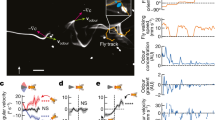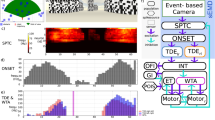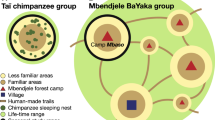Abstract
Desert ants (Cataglyphis) are renowned for their ability to perform large-scale foraging excursions and then return to the nest by path integration. They do so by integrating courses steered and the distances travelled into a continually updated home vector1. Whereas the angular orientation is based on skylight cues2, how the ants gauge the distances travelled has remained largely unclear3,4. Furthermore, almost all studies on path integration in Cataglyphis5,6, as well as in spiders7,8, rodents9, and humans10,11, have aimed at understanding how the animals compute homebound courses in the horizontal plane. Here, we investigate for the first time how an animal's odometer operates when a path integration task has to be accomplished that includes a vertical component. We trained Cataglyphis ants within arrays of uphill and downhill channels, and later tested them on flat terrain, or vice versa. In all these cases, the ants indicated homing distances that corresponded not to the distances actually travelled but to the ground distances; that is, to the sum of the horizontal projections of the uphill and downhill segments of the ants' paths.
This is a preview of subscription content, access via your institution
Access options
Subscribe to this journal
Receive 51 print issues and online access
$199.00 per year
only $3.90 per issue
Buy this article
- Purchase on Springer Link
- Instant access to full article PDF
Prices may be subject to local taxes which are calculated during checkout


Similar content being viewed by others
References
Müller, M. & Wehner, R. Path integration in desert ants, Cataglyphis fortis. Proc. Natl Acad. Sci. USA 85, 5287–5290 (1988).
Wehner, R. in Orientation and Communication in Arthropods (ed. Lehrer, M.) 145–185 (Birkhäuser, Basel, 1997).
Ronacher, B. & Wehner, R. Desert ants Cataglyphis fortis use self-induced optic flow to measure distances travelled. J. Comp. Physiol. A 177, 21–27 (1995).
Ronacher, B., Gallizzi, K., Wohlgemuth, S. & Wehner, R. Lateral optic flow does not influence distance estimation in the desert ant Cataglyphis fortis. J. Exp. Biol. 203, 1113–1121 (2000).
Wehner, R. & Wehner, S. Insect navigation: use of maps or Ariadne's thread. Ethol. Ecol. Evol. 2, 27–48 (1990).
Müller, M. & Wehner, R. The hidden spiral: systematic search and path integration in desert ants, Cataglyphis fortis. J. Comp. Physiol. A 175, 525–530 (1994).
Seyfarth, E. A., Hergenröder, R., Ebbes, H. & Barth, F. G. Idiothetic orientation of a wandering spider: compensation of detours and estimates of goal distance. Behav. Ecol. Sociobiol. 11, 139–148 (1982).
Görner, P. & Claas, B. in Neurobiology of Arachnids (ed. Barth, F. G.) 275–297 (Springer, Berlin, 1985).
Etienne, A. S., Maurer, R. & Seguinot, V. Path integration in mammals and its interaction with visual landmarks. J. Exp. Biol. 199, 201–209 (1996).
Sauve, J. P. L’orientation spatiale: Formalisation d’un modèle de mémorisation égocentrée et expérimentation chez l’homme. PhD thesis, Univ. Aix-Marseille (1989).
Loomis, J. M. et al. Nonvisual navigation by blind and sighted: assessment of path integration ability. J. Exp. Psychol. Gen. 122, 73–91 (1993).
Wehner, R. in Neural basis of Behavioural Adaptation (eds Schildberger, K. & Elsner, N.) 103–143 (G. Fischer, Stuttgart, 1994).
Srinivasan, M. V., Zhang, S. W., Lehrer, M. & Collett, T. S. Honeybee navigation en route to the goal: visual flight control and odometry. J. Exp. Biol. 199, 237–244 (1996).
Srinivasan, M. V., Zhang, S. W. & Bidwell, N. J. Visually mediated odometry in honeybees. J. Exp. Biol. 200, 2513–2522 (1997).
Srinivasan, M. V., Zhang, S., Altwein, M. & Tautz, J. Honeybee navigation: nature and calibration of the ‘odometer’. Science 287, 851–853 (2000).
von Frisch, K. The Dance Language and Orientation of Bees (Harvard Univ. Press, Cambridge, Massachusetts, 1967).
Heran, H. Ein Beitrag zur Frage nach der Wahrnehmungsgrundlage der Entfernungsweisung der Bienen (Apis mellifica L.). Z. Vergl. Physiol. 38, 168–218 (1956).
Taylor, C. R., Caldwell S. L. & Rowntree, V. J. Running up and down hills: some consequences of size. Science 178, 1096–1097 (1972).
Schäfer, M. & Wehner, R. Loading does not affect measurement of walking distance in desert ants Cataglyphis fortis. Verh. Deutsch. Zool. Ges. 86, 270 (1993).
Esch, H. E. & Burns, J. E. Distance estimation by foraging honeybees. J. Exp. Biol. 199, 155–162 (1996).
Mittelstaedt, H. & Mittelstaedt, M. Mechanismen der Orientierung ohne richtende Aussenreize. Fortschr. Zool. 21, 46–58 (1973).
Markl, H. Borstenfelder an den Gelenken als Schweresinnesorgane bei Ameisen und anderen Hymenopteren. Z. Vergl. Physiol. 45, 475–569 (1962).
Hill, D. E. Orientation by jumping spiders of the genus Phidippus (Araneae: Salticidae) during the pursuit of prey. Behav. Ecol. Sociobiol. 5, 301–322 (1979).
Bardunias, P. M. & Jander, R. Three dimensional path integration in the house mouse. Naturwissenschaften 87, 532–534 (2000).
Wehner, R. & Srinivasan, M. V. Searching behaviour of desert ants, genus Cataglyphis (Formicidae, Hymenoptera). J. Comp. Physiol. 142, 315–338 (1981).
Acknowledgements
We thank H. Gansner for her help in running the experiments and the members of the Zurich–Maharès crew for their co-operation in the field. We further thank H. Heise for the construction of the channel arrays and U. Menzi and H. Michel for their help in designing the figures and preparing the manuscript. Financial support came from the Swiss National Science foundation and the G. & A. Claraz foundations, grants to R.W.
Author information
Authors and Affiliations
Corresponding author
Rights and permissions
About this article
Cite this article
Wohlgemuth, S., Ronacher, B. & Wehner, R. Ant odometry in the third dimension. Nature 411, 795–798 (2001). https://doi.org/10.1038/35081069
Received:
Accepted:
Issue Date:
DOI: https://doi.org/10.1038/35081069
This article is cited by
-
Path integration in a three-dimensional world: the case of desert ants
Journal of Comparative Physiology A (2020)
-
The Cataglyphis Mahrèsienne: 50 years of Cataglyphis research at Mahrès
Journal of Comparative Physiology A (2019)
-
An ant-inspired model for multi-agent interaction networks without stigmergy
Swarm Intelligence (2018)
-
Beyond pheromones: evolving error-tolerant, flexible, and scalable ant-inspired robot swarms
Swarm Intelligence (2015)
-
Where paths meet and cross: navigation by path integration in the desert ant and the honeybee
Journal of Comparative Physiology A (2015)
Comments
By submitting a comment you agree to abide by our Terms and Community Guidelines. If you find something abusive or that does not comply with our terms or guidelines please flag it as inappropriate.



